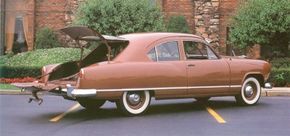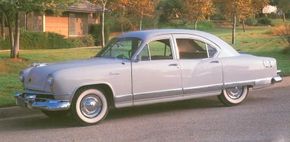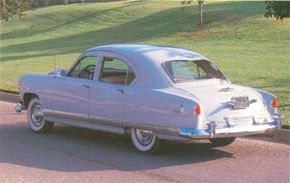The 1951-1953 Kaiser Traveler was the brainchild of entrepreneur Henry J. Kaiser -- who, it was said, averaged about 100 ideas an hour and about one of them was good. The good ones, however, were worth pausing over. During World War II, one of these was Kaiser's "cookie cutter" production line of Liberty and Victory ships, which broke the U-boat threat by sheer numbers; after the war, another idea emerged as the Kaiser Traveler: the first hatchback.
Advertisement
Improbable as it seems, the story really is true. Henry Kaiser conceived the 1951-1953 Kaiser Traveler by tracing the outlines of its double-opening hatches with his finger in the dust on a sedan in the Kaiser garage in Oakland. At that point, the idea was simplistic: cut out the entire deck and rear window area, hinge half of it to lift up and half to flop down, let them meet about halfway on the deck, and presto: a new kind of utility car.
It wasn't quite so easy; 200 changes had to be made to the basic sedan before the Kaiser Traveler could be built. It required stronger springs and shocks to handle the increased payload, new floor pan wiring, a method to display the license plate, and reinforcement "all over hell" (according to engineer Ralph Isbrandt) to replace lost stiffness.
The detail execution on the Kaiser Traveler was clever. Harvey Anscheutz, Kaiser-Frazer's head of body development, spent three weeks with the laws of 48 states on his desk, devising a lighted license plate holder that would flop down when the deck was lowered without violating any position or visibility laws.
A big, T-shaped handle was devised to ease the operation of the hatches on the Kaiser Traveler, and a strong piano hinge strengthened the lower hatch. When open, this member was suspended by strong chains, bagged in vinyl to prevent rattles. Anscheutz also created a folding rear seat by tilting the cushion forward against the front seats and lowering the backrest to extend the cargo platform to its seven-foot length. The seat folding method is still used in wagons today.
Some aspects were makeshift, however: on the 1949-1950 models, which lacked a sub-floor spare tire compartment, the left rear doors were welded shut and the spare bolted to the inside panel. (To confuse matters they dummied up a non-operable outside door handle, which must have frustrated many a passenger.) But this problem was handily cured on the handsomely restyled 1951 Kaiser Travelers.
To see how Kaiser further updated its models on the 1951-1953 Kaiser Traveler, keep reading.
For more information on cars, see:
- Classic Cars
- Muscle Cars
- Sports Cars
- Consumer Guide New Car Search
- Consumer Guide Used Car Search
Advertisement


